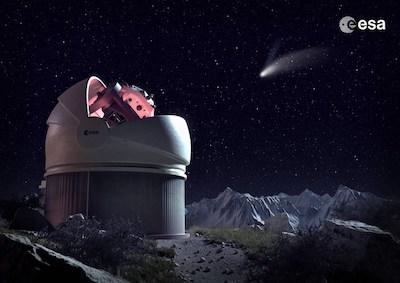Participating In Major International Asteroid Impact Exercise
For the first time, ESA will cover a major international asteroid impact exercise live via social media, highlighting the actions that might be taken by scientists, space agencies and civil protection organizations.

Every two years, asteroid experts from across the globe come together to simulate a fictional but plausible imminent asteroid impact on Earth. During the week-long scenario, participants – playing roles such as ‘national government’, ‘space agency’, ‘astronomer’ and ‘civil protection office’ – don't know how the situation will evolve from one day to the next, and must make plans based on the daily updates they are given.
The exercise is being produced by experts from NASA’s Planetary Defense Coordination Office working together with the US Federal Emergency Management Agency at the 2019 Planetary Defense Conference, Washington DC. The conference is the world’s most important gathering of asteroid experts, and is strongly supported by ESA, NASA and other agencies, organisations and scientific institutions. "The first step in protecting our planet is knowing what’s out there,” says Rüdiger Jehn, ESA’s Head of Planetary Defence.
“Only then, with enough warning, can we take the steps needed to prevent an asteroid strike altogether, or to minimize the damage it does on the ground.”
As of April 2019, 20,000 asteroids whose orbit brings them near Earth have been found. At the current rate of roughly 150 new discoveries every month, this number is set to rapidly increase. With the planned deployments of ESA’s new Flyeye and Test-Bed Telescopes, Europe’s ability to discover, confirm and understand the ancient rocks that hurtle through space will grow – fundamental to implementing mitigation measures.
The @esaoperations Twitter channel will share updates on the asteroid impact exercise in realtime, including daily press releases revealing how the asteroid impact scenario will evolve, so followers will find out the ‘news’ as the experts do.
There will be a live stream video from the Planetary Defense Conference on Thursday afternoon. It will be streamed on the ESA Facebook page. For daily updates on the asteroid impact scenario, check out “Rolling coverage: Brace for hypothetical asteroid impact” on ESA's Rocket Science blog. blogs.esa.int/rocketscience/
The scene has been set for this year’s hypothetical impact scenario. Although realistic, it is completely fictional and does not describe an actual asteroid impact.
The exercise assumes that an asteroid was discovered on 26 March 2019 and was given the name '2019 PDC' by the Minor Planet Center. Very little is known about this newly discovered asteroid’s physical properties. With a magnitude (brightness) of 21.1 – invisible to the naked eye but viewable by professional astronomers – it has been classed as a ‘Potentially Hazardous Asteroid’, and experts have determined its average size could be anywhere from 100-300 meters (110-330 yards).
The day after 2019 PDC was discovered, ESA and NASA’s ‘impact monitoring systems’ identified several future dates when the asteroid could hit Earth. At this early stage, with not many observations yet recorded, both systems agreed that the asteroid was most likely to strike on April 29, 2027 – more than eight years away – with a probability of impact of about 1 in 50,000.
Astronomers continued to monitor the asteroid for a month after its initial detection, which provided them more information about the object’s trajectory, and have now discovered that the chance of impact is rapidly increasing. By April 29, 2019, (the first day of the Planetary Defence Conference), the probability of impact has risen to 1 in 100.
The 2019 Planetary Defence Conference will be the sixth such conference that the International Academy of Astronautics (IAA) has held; and ESA has been closely involved with all of them.
As in previous years, ESA is sponsoring the event and providing a conference co-chair. A large team of ESA experts will also be present, including members of the Agency’s Near-Earth Object Coordination Centre and the Hera asteroid deflection mission.
During the hypothetical asteroid impact scenario, ESA experts will participate in discussions on the possible risks posed by asteroid 2019 PDC, and what responses could be considered. “Fortunately, impacts from medium and large asteroids are not very common,” explains Detlef Koschny, senior asteroid expert at ESA who will be involved in the hypothetical scenario.”
“However, this means we have little opportunity to practise our response to this very real – though unlikely – danger. This year’s impact scenario is a very unique chance to run through, in real-time, an asteroid impact.”
Solar activity, asteroids and artificial space debris all pose threats to our planet and our use of space.
ESA's Space Safety activities aim to safeguard society and the critical satellites on which we depend, identifying and mitigating threats from space through projects such as the Flyeye telescopes, the Lagrange space weather mission and the Hera asteroid mission.
As asteroid experts meet for the international Planetary Defense Conference, ESA is focusing on the threat we face from space rocks. How likely is an asteroid impact? What is ESA doing to mitigate impact risks? Follow the hashtag #PlanetaryDefense to find out more.
(Image provided with ESA news release)
 ANN's Daily Aero-Term (04.25.24): Airport Rotating Beacon
ANN's Daily Aero-Term (04.25.24): Airport Rotating Beacon ANN's Daily Aero-Linx (04.25.24)
ANN's Daily Aero-Linx (04.25.24) Klyde Morris (04.22.24)
Klyde Morris (04.22.24) Airborne 04.24.24: INTEGRAL E, Elixir USA, M700 RVSM
Airborne 04.24.24: INTEGRAL E, Elixir USA, M700 RVSM Airborne 04.22.24: Rotor X Worsens, Airport Fees 4 FNB?, USMC Drone Pilot
Airborne 04.22.24: Rotor X Worsens, Airport Fees 4 FNB?, USMC Drone Pilot



